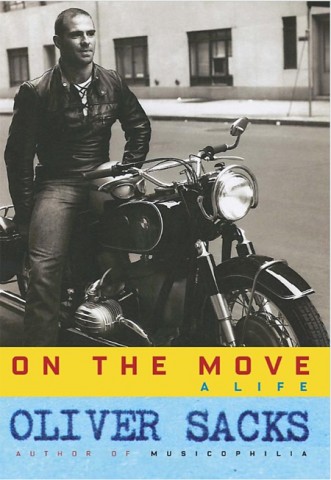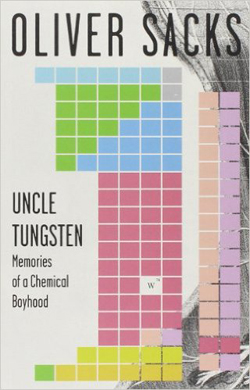 On the Move: A Life
On the Move: A Life
by Oliver Sacks
Published by Vintage Books
Published April 28, 2015
Nonfiction (history/memoir)
416 pp. • Find on Amazon.com
Reviewed by Stephen O. Murray
October 3, 2015
Oliver Sacks, who died August 30 at the age of 82, was a neurologist who sought to understand how human brains work by close examination of people trying to work around abnormalities including deafness and color-blindness. His memoir, On the Move, published just before his death, recall serious addiction to methamphetamines, extreme bodybuilding (squat pressing half a ton and more), suicidally protracted motorcycle rides, occasional losses of book-length manuscripts, recurrent problems with bosses (including plagiarism by a clinic head who had forbidden him to publish Migraine), and failures in a research career.
His sexual orientation toward males is revealed early in the book. Although he says that he accepted it early on, and at age 18 told his father that he preferred boys, he was deeply hurt by his mother’s reaction of regret that he had ever been born. Though she never mentioned homosexuality again to him and gave him sage career advice for many decades, the self-loathing persisted, underlying more than a little risk-taking that is easy to interpret as self-destructiveness.
Sacks had amours of various lengths and then did not have sex for thirty-five years following his delight-filled 40th birthday fling with a handsome Harvard student/swimmer. Though grateful to have found love in old age (beginning in 2008) with Bill Hayes, Sacks does not analyze the long moratorium, not even to register whether he renounced sex for some conscious reasons or whether his libido just shut down. For an addictive personality prone to excess, he quit sex but also drugs, epic motorcycle trips, and bodybuilding “cold turkey.” I’d say that even his abstinences were lacking in moderation.
The book does not lack for candor, but is not very introspective for a memoir of almost four hundred pages. This is a man who became famous for his close analysis of how others lived, but explaining his own unusual sexual history is not a task he took on. He writes about being very shy and about not being able to recognize faces (cogenial prosopagnosia), but it seems to me that his heavy drug-taking was partly a flight from shame and guilt about homosexuality. In 1982, he told a friend: “My analyst tells me he’s never encountered anyone less affected by gay liberation. I remain locked in my cell despite the dancing at the prison gates.”

In his memoir of his youth, Uncle Tungsten: Memoirs of a Chemical Boyhood, Sacks laconically wrote that as a young man he had “identified at times with the inert gases…imagining them lonely, cut off, yearning to bond.”
Later, though he generally biked alone, he felt some commonality with other black-leather-clad motorcyclists but not with other gay men qua gay men or, for that matter, with other drug abusers. (The he was an “abuser” not a “user” is clearly Sacks’s view, not that he expresses regret, and, indeed, he remained grateful for LSD trips opening his mind. Methamphetamines, however, he characterized as “empty ecstasy.”) Or with other physicians, not even other Jewish ones. The only thing startling about his statement late in the book that “it has sometimes seemed to me that I have lived at a certain distance from life” is the “sometimes.” The isolation of City Island, particularly his house on the water there, is a metaphor for this. (Though there is community there, Sacks was not part of it).
The book is a set of memoirs in the plural rather than a memoir in that segments cover particular topics. The general direction of the book is chronologically forward, but particular segments follow through into what was a future at the time of the next segment. His long friendship with fellow British expatriate, poet Thom Gunn, comes in two segments; that with W. H. Auden in one. There are also tributes to physicist-turned-biochemist Francis Crick, psychologists A. R. Luria and Jerome Bruner, director (and neurologist) Jonathan Miller, actors Robin Williams (who played/mimicked Sacks in the 1990 screen adaptation of Sacks’s book Awakenings) and Robert De Niro (who stayed in character as one of Sacks’s patients in the same movie), and an extended exegesis of the work of neurophysiologist Gerald Edelman, author of The Mindful Brain.
Sacks recalls Edelman telling him, “You’re no theoretician,” to which Sacks replied: “I know … but I am a field-worker, and you need the sort of fieldwork I do for the sort of theory making you do.” Edelman agreed, and Sacks left a body of case studies that have helped rethinking of brain functioning and malfunctioning.
Most of the memoirs are about professional rather than personal matters, though Sacks, here and in his other writings, is always somewhere in the frame.
Though the memoirs are titled On the Move and record having sped across more than 100,000 miles on motorcycles, Sacks settled in New York City (eventually on City Island) in 1965 (and never got around to becoming a U.S. citizen). A vast archive, including more than a thousand volumes of diaries, masses of clinical notes (“I see 10 patients a day and write 500 words on each meeting — a thousand patients a year, a thousand stories”) and video recordings were stored there.
Sacks reported difficulties in turning this mass of documents into the stories he became famous for telling, though he integrated material from diaries and old letters fairly smoothly into On the Move. Other long-gestating books were finally written quickly (dare I say in “binges”?), starting with the first one, Migraine, written in nine days.
And as his profession reluctantly came to accept greater plasticity of brain functioning and less simplistic, mechanistic models, Oliver Sacks’s method remained the same (with professional distrust of “popularizers”). As Rita Charon describes it, for every human puzzle confronting him, “he entered with the conviction that he could make sense of what he perceived. He was convinced that if he took enough time and discernment, he would be able to see the meaning of what to others seemed bizarre or crazy… He has helped us see that patients don’t only want to be cured of what ails them. They know that this is not always possible. What they crave is someone to believe them.”
This review was published in Out In Jersey, winter issue, 2015
©2015, 2016, Stephen O. Murray

